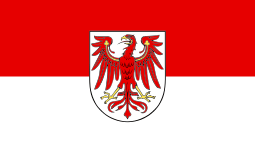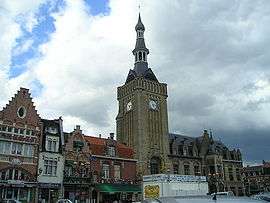Bailleul, Nord
| Bailleul Belle | ||
|---|---|---|
|
Market place and belfry of Bailleul | ||
| ||
 Bailleul | ||
|
Location within Hauts-de-France region  Bailleul | ||
| Coordinates: 50°44′21″N 2°44′00″E / 50.7392°N 2.7333°ECoordinates: 50°44′21″N 2°44′00″E / 50.7392°N 2.7333°E | ||
| Country | France | |
| Region | Hauts-de-France | |
| Department | Nord | |
| Arrondissement | Dunkerque | |
| Canton | Bailleul-Nord-Est and Bailleul-Sud-Ouest | |
| Intercommunality | Monts de Flandres - Plaine de la Lys | |
| Government | ||
| • Mayor (2008–2014) | Michel Giloen | |
| Area1 | 43.42 km2 (16.76 sq mi) | |
| Population (2009)2 | 13,989 | |
| • Density | 320/km2 (830/sq mi) | |
| Time zone | CET (UTC+1) | |
| • Summer (DST) | CEST (UTC+2) | |
| INSEE/Postal code | 59043 / 59270 | |
| Elevation |
14–86 m (46–282 ft) (avg. 44 m or 144 ft) | |
|
1 French Land Register data, which excludes lakes, ponds, glaciers > 1 km² (0.386 sq mi or 247 acres) and river estuaries. 2 Population without double counting: residents of multiple communes (e.g., students and military personnel) only counted once. | ||
Bailleul (Belle in Dutch) is a commune in the Nord department in northern France. It is located in French Flanders, 3 km (2 mi) from the Belgian border and 26 km (16 mi) northwest of Lille.
Population
| Population of Bailleul since 1793 | ||
|---|---|---|
| Year | Pop. | ±% |
| 1793 | 11,576 | — |
| 1800 | 8,944 | −22.7% |
| 1806 | 9,222 | +3.1% |
| 1821 | 9,475 | +2.7% |
| 1831 | 9,823 | +3.7% |
| 1836 | 9,911 | +0.9% |
| 1841 | 9,923 | +0.1% |
| 1846 | 10,141 | +2.2% |
| 1851 | 10,078 | −0.6% |
| 1856 | 10,108 | +0.3% |
| 1861 | 10,102 | −0.1% |
| 1866 | 12,896 | +27.7% |
| 1872 | 12,828 | −0.5% |
| 1876 | 12,968 | +1.1% |
| 1881 | 12,712 | −2.0% |
| 1886 | 13,335 | +4.9% |
| 1891 | 13,276 | −0.4% |
| 1896 | 13,449 | +1.3% |
| 1901 | 13,530 | +0.6% |
| 1906 | 13,573 | +0.3% |
| 1911 | 13,251 | −2.4% |
| 1921 | 6,651 | −49.8% |
| 1926 | 8,545 | +28.5% |
| 1931 | 9,691 | +13.4% |
| 1936 | 10,928 | +12.8% |
| 1946 | 11,352 | +3.9% |
| 1954 | 11,964 | +5.4% |
| 1962 | 12,583 | +5.2% |
| 1968 | 13,077 | +3.9% |
| 1975 | 13,474 | +3.0% |
| 1982 | 13,400 | −0.5% |
| 1990 | 13,847 | +3.3% |
| 1999 | 14,136 | +2.1% |
| 2006 | 13,616 | −3.7% |
| 2009 | 13,989 | +2.7% |
Heraldry
.svg.png) |
The arms of Bailleul are blazoned : Gules, a cross vair.' |
Media
Bailleul is the birthplace of French filmmaker Bruno Dumont and served as the setting for his first two feature films. This area is also a setting in the Timothy Findley book The Wars.
Carnival
The inhabitants of Bailleul celebrate carnival with five days of processions and other festivities. The carnival has taken place since 1853, when the Philanthropic Company of Bailleul was founded. During the event, a search takes place for the needy ones of the city. The Gargantua Giant chairs the festivities, seated on his float and accompanied by his kitchen boys.
At the end of Shrove Tuesday, after the final procession of around 50 floats, with local groups, brass bands and plenty of confetti, Doctor Francisco Piccolissimo tries to cure the excesses of some inhabitants in an unconventional way in front of the town hall, and the festival continues late into the night in the town's cafés and bars.
Points of interest
Railways
Bailleul has a railway station on the line from Lille to Calais and Dunkirk.
International relations
Bailleul is twinned with:
-

 Werne, North Rhine-Westphalia, Germany since 1967
Werne, North Rhine-Westphalia, Germany since 1967 -
 Hawick, Scottish Borders, Scotland, UK since 1973
Hawick, Scottish Borders, Scotland, UK since 1973 -
.svg.png) Izegem, West Flanders, Belgium since 1992
Izegem, West Flanders, Belgium since 1992 -
 Yaka, Togo
Yaka, Togo -

 Kyritz, Brandenburg, Germany since 2012
Kyritz, Brandenburg, Germany since 2012
Personalities
- Edmond de Coussemaker
- Pharaon de Winter, painter
- Marguerite Yourcenar, academic
- Jean Delobel, politician
- Michel Delebarre, politician
- Bruno Dumont, director and filmmaker
- Philippe Édouard Léon Van Tieghem, Biologist and botanist born in Bailleul in 1839
- Jean-Luc Samyn, jockey in American thoroughbred racing
See also
References
| Wikimedia Commons has media related to Bailleul (Nord). |

_Nord-France.svg.png)